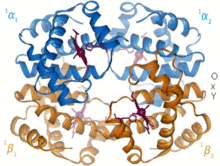Pigment (biology)

As pigment (Latin pigmentum , color, coloring matter ') are in the biology all color -imparting substances and structures in the cells on and referred to multicellular organisms.
Pigments can be indispensable in a cell, for example the bacteriochlorophylls for anoxygenic photosynthesis or the chlorophylls for an oxygenic one in which oxygen is formed. They can also be necessary for cell respiration (like cytochromes ). Furthermore, they can be used in multicellular organisms for oxygen storage ( myoglobins ), oxygen transport ( hemoglobins ), light perception ( photopigments ) or light protection ( melanins ).
Pigments are also used for inconspicuous surfaces ( camouflage ) or for conspicuous signals. In this way they can be found in the surface formations of many plants and animals, for example in the cuticle and fruit shell , leaf and flower , conch shell or chitin shell , snail shell , butterfly wing , bird's feather , scales , hair or skin .
The colored effect can result from the selective absorption of light in the color-bearing part of soluble dyes or insoluble pigments called the chromophore . It can also be caused by reflection , scattering and refraction on (often multilayered) structures, possibly with iridescent effects due to interference .
Biological pigments are usually stored in membranes and cells. A pigment-bearing membrane covering within cells is called a chromatophore , also a membrane-covered plastid ; the granular stacks of lamellas inside chloroplasts are called grana . A pigment cell is also known as a chromatophore , one (melanophore) in the skin of primates is the melanocyte , in whose membrane-enclosed organelles ( melonosome ) the pigment melanin is formed. Their transmission to horn- forming cells largely determines the natural color of skin and hair , also in humans.
Pigments in Plants
The most important pigments contained in plants and algae , which are also responsible for the green color of embryophytes and green algae , are chlorophylls . All plants (Reich Archaeplastida = Plantae) and algae contain chlorophyll a. In addition to morphological differences, the archaeplastida are divided into three subgroups according to the type of pigments they also contain, depending on whether they also contain chlorophyll b, xanthophylls and / or phycobilins .
Algae with complex plastids , which originate from an endosymbiosis with a red alga, contain chlorophyll b instead of chlorophyll c.
The phycobilisomes , the light-harvesting complex of cyanobacteria , red algae , Glaucocystophyceen and thekaten amoeba Pauli Ella chromatophora consist of biliproteins . While phycocyanin and allophycocyanin are present in all phycobilisomes , phycoerythrin is only formed in red algae and cyanobacteria - but not in all of them. Instead of phycobilisomes, Cryptophyceae contain only a single, highly modified phycoerythrin as a light-harvesting complex.
The pigments also include the anthocyanins and flavones dissolved in the cell sap , as well as the phlobaphenes that are embedded in the walls of dead cells.
Pigments in humans and animals
In animals, the melanins , carotenoids , guanine and the bile pigments are the most important pigments. The pigments are found in skin , hair, scales, feathers or chitin armor , among other things . Animal pigments can be concentrated in pigment cells ( chromatophores ) or dissolved in body fluids .
Butterflies create additional color effects by interfering with the scales. Skeletons and shells made of calcium carbonate (lime), such as those found in sponges , mussels or snails , can contain inorganic pigments.
The skin color of mammals is mainly caused by melanins. Hemoglobin , the coloring substance of the blood of vertebrates , changes the color of the iron- hemoglobin complex from red to red-violet when it absorbs and releases molecular oxygen . The cause is a structural change with a constant oxidation number of + II of the iron atom in the heme .
If the pigment formation is reduced it is called hypopigmentation , if it is increased it is called hyperpigmentation .
use
Some commercially used organic pigments, such as the brightly colored Indian yellow from the urine of cows, were made directly from plant or animal products. However, they lost more and more importance due to the synthetic organic pigments available since the end of the 19th century.
| pigment | origin | colour |
|---|---|---|
| Indian yellow | Cow urine | yellow |
| Crocin | saffron | yellow |
| purple | Purple snail | purple |
| alizarin | Dyer's madder root | turkish red |
| Carmine | Cochineal scale insect | red |
| Kermes | Kermess scale louse | red-brown |
| Kermes | Pokeweed | red-brown |
| indigo | Indian indigo plant | blue |
| indigo | Leaves of woad | blue |
Individual evidence
- ^ A b Graham LE, Graham JM, Wilcox LW (2009) Algae , 2nd edition. Benjamin Cummings (Pearson), San Francisco, CA. ISBN 978-0-321-55965-4 .
- ↑ a b Raven PH, Evert RF, Eichhorn SE (2006) Biology of Plants . 4th edition. Verlag de Gruyter, Berlin. ISBN 978-3-11-018531-7 .
- ^ Adl SM, Simpson AG, Farmer MA, Andersen RA, Anderson OR, Barta JR, Bowser SS, Brugerolle G, Fensome RA, Fredericq S, James TY, Karpov S, Kugrens P, Krug J, Lane CE, Lewis LA, Lodge J, Lynn DH, Mann DG, McCourt RM, Mendoza L, Moestrup O, Mozley-Standridge SE, Nerad TA, Shearer CA, Smirnov AV, Spiegel FW, Taylor MF: The New Higher Level Classification of Eukaryotes with Emphasis on the Taxonomy of Protists . In: Journal of Eukaryotic Microbiology . tape 52 , no. 5 , October 2005, p. 399-451 , doi : 10.1111 / j.1550-7408.2005.00053.x .
- ↑ Phlobaphene biosynthesis in maize. Ohio State University , November 29, 2011, accessed April 21, 2017 .
- ↑ a b Meyer's large pocket dictionary ; Volume 17; 3. Edition; Bibliographical Institute & FA Brockhaus AG; Mannheim 1990; ISBN 3-411-11173-9 .